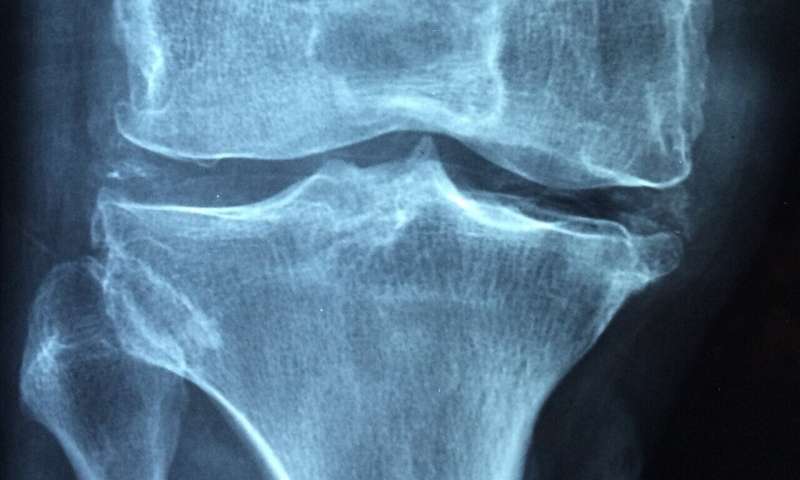Gene that protects against osteoarthritis identified

Osteoarthritis is one of the most common problems associated with aging, and although there are therapies to treat the pain that results from the breakdown of the cartilage that cushions joints, there are no available therapies to modify the course of the disease.
However, working in a mouse model of the disorder, researchers at Washington University School of Medicine in St. Louis have found that a molecule previously linked to diabetes, cancer and muscle atrophy also seems to be involved in the development of osteoarthritis and may be a useful treatment target.
When the gene involved, FoxO1, is knocked out in mice, the animals develop osteoarthritis. But when the researchers increase the levels of the FoxO1 molecule in mice that are developing osteoarthritis, the animals exhibit less cartilage damage.
The study is available online in Proceedings of the National Academy of Sciences.
“Osteoarthritis, or joint degeneration, is a disease that affects more than 32 million people in the U.S. alone but that does not have a medical therapy to alter its progression,” said senior investigator Regis J. O’Keefe, MD, Ph.D., the Fred C. Reynolds Professor of Orthopedic Surgery and head of the Department of Orthopedic Surgery. “A better understanding of the fundamental processes involved in osteoarthritis and the degeneration of cartilage is required if we’re going to be more successful in treating this very common and very expensive disorder.”
O’Keefe said that commonly, people with osteoarthritis have suffered knee injuries that damaged the knee’s meniscus. Over time, arthritis then can develop in the joint.
“Unlike skin or bone or other organs that can regenerate in response to injury, cartilage has very little regenerative potential,” he said.
However, when the mice in these experiments had elevated levels of the FoxO1 molecule, osteoarthritis’s progress was slowed or even reversed. The researchers believe the molecule interferes with cartilage damage and the development of arthritis by enhancing a process called autophagy in the arthritic joint. Autophagy is the body’s way of clearing out damaged tissue. In these experiments, the researchers found that autophagy was disrupted in the mice with reduced levels of FoxO1 and that the process was enhanced in animals with higher levels of the molecule.
“In other words, maintaining a higher level of autophagy seemed to be beneficial to maintaining these cartilage cells and, thus, maintaining a healthy knee joint,” said co-corresponding author Jie Shen, assistant professor of orthopedic surgery.
O’Keefe said that raises the possibility of delivering FoxO1 to arthritic joints through nanotechnology as a way to regulate autophagy and keep joints healthier.
“In mice with injuries that typically progress to become osteoarthritis, the knee joints still appear normal about a week after injury,” O’Keefe explained. “But when we measure autophagy in the cartilage after injury to those same knee joints, although the joints themselves look fine, the autophagy process already is shut off. The injury completely turns it off, and once autophagy is off, the cartilage begins to degenerate.”
Source: Read Full Article


